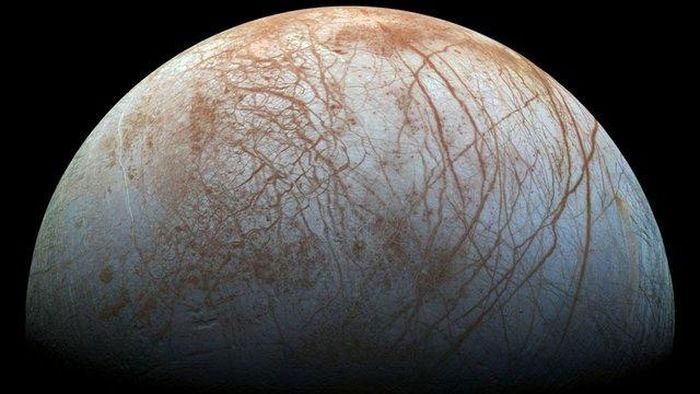Europa, one of Jupiter’s moons, has long captured the attention of scientists due to its thick icy crust that conceals a subsurface ocean.
Jets of water erupt from cracks in the ice, releasing components of this ocean into space.
According to scientists, ocean worlds like Europa are the best candidates for searching for evidence of extraterrestrial life. This is because salt and water are abundant under Earth-like conditions, which are essential for life.
The chemical signatures of the red streaks on Europa’s surface, believed to be a mixture of frozen water and salt, appear unusual as they do not match any known substances on Earth.

Europa, a moon of Jupiter, contains a subsurface ocean beneath its thick icy crust. The red streaks are believed to be a mixture of frozen water and a type of salt not found on Earth. (Image Source: NASA)
In 2019, scientists identified that the yellow regions on Europa’s surface are due to the presence of sodium chloride – commonly known as table salt.
Both Europe and the United States have shown interest in exploring the ocean moon Europa. The European Space Agency’s JUICE mission (Jupiter Icy Moons Explorer) and NASA’s Europa Clipper mission are set to explore these celestial bodies in the coming years.
To gain deeper insights into Europa, scientists have been working to recreate the conditions of this “moon” in laboratory settings.
The research team discovered that combining water, table salt, cold temperatures, and high pressure created a new type of solid crystal — a substance that may exist on the surface of Europa as well as on the ocean floor beneath it.
The icy crust that forms Europa’s surface is estimated to be between 16 to 24 kilometers thick, while the ocean of this “moon” is estimated to be between 64 to 161 kilometers deep.
Understanding the chemical composition present on ocean worlds like Europa will allow scientists to better interpret data collected by the future JUICE and Europa Clipper missions.
Scientist Baptiste Journaux from the University of Washington stated: “These are the only planetary bodies, outside of Earth, where liquid water is stable over geological timescales, which is crucial for the emergence and development of life.”
“In my opinion, these ‘moons’ are the best places in our Solar System to explore for extraterrestrial life. Therefore, we need to study the oceans and the strange components within them to better understand how these oceans form, evolve, and can sustain liquid water in the frigid regions of the Solar System, far from the Sun,” said scientist Baptiste Journaux.


















































